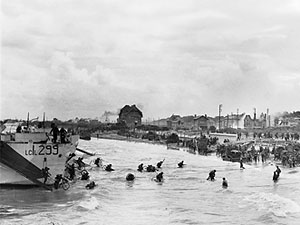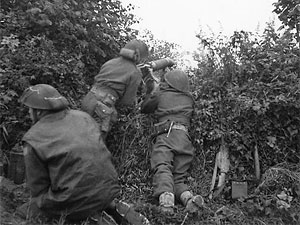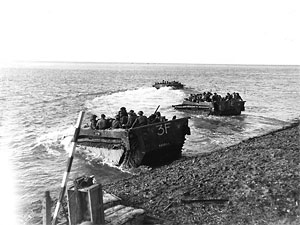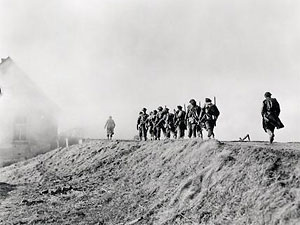Organization
- Reconnaissance
17th Duke of York’s Royal Canadian Hussars - 7th infantry brigade
The Royal Winnipeg Rifles
The Regina Rifle Regiment
1st Canadian Scottish Regiment - 8th infantry brigade
The Queen’s Own Rifles of Canada
Régiment de la Chaudiere
The North Shore Regiment - 9th infantry brigade
The Highland Light Infantry of Canada
The Stormont, Dundas, and Glengarry Highlanders
The North Nova Scotia Highlanders - Support
Ottawa’s Cameron Highlanders - Artillery
12th field artillery regiment
13th field artillery regiment
14th field artillery regiment
3rd anti-tank regiment
4th light anti-aircraft regiment - Engineers
- Signals
- Services
History
Origins
A 3rd Canadian infantry division had been committed in Europe during the First World War, as part of the Canadian Expeditionary Force. Constituted in December 1915, it fought in northern France and in Flanders. During operations against Ypres, its commander, Mercer, had the dubious privilege to be the highest ranking Canadian officer killed in action; Williams, commander of the 9th brigade, was from his side the highest ranking Canadian to be captured… The 3rd infantry division was inactivated at the end of the conflict, but its tradition was to remain alive through the shoulder sleeve – the “blue horizon” color pointed out the memory of the trenches.
With Germany having started Second World War, Canadian federal government decided to activate the 3rd ID anew, on May 17th, 1940. However, general lack of readiness, absence of clear decision on the recourse or not to conscription, as well as uncertainties as for the evolution of the conflict handicapped its organization until the end of the year. Gradually, training of 3rd ID started and made it possible to improve skills and combat drills of the 3rd ID. While waiting for the transfer in Great Britain, Ottawa’s Cameron Highlanders were dispatched to Iceland in order to reinforce the garrison of the island. Finally, 3rd ID was transported to the United Kingdom in July 1941. Not less than three years of hard training awaited its soldiers, during which the 3rd ID took part in various series of operations, more particularly in the south of England and in Scotland.
From Juno Beach to Falaise
Third Canadian ID was selected to take part in operation Overlord, its troops being assigned as first waves on Juno Beach. Its D-Day target was Carpiquet, located 18 km inshore. To perform this task, 3rd ID was reinforced by the 2nd Canadian armoured brigade.
On June 6th, 8:00 AM, first Canadian soldiers started to land on Juno Beach. After having successfully suppressed german defences on the beach, their progression developed as one of the most remarkable, but Canadians could not advance beyond Buron. Until June 11th, they were continuously counter-attacked by 12th SS-PzD – Putot, Bretteville or Mesnil-Patry changed hand several times.

After four weeks of an exhausting static war, the division was launched against Carpiquet, on July 4th. Canadians were supported by divisional and corps artillery, increased by heavy guns from cruiser HMS Rodney. The airfield was defended by hardly a company of SS-Hitlerjugend, strongly entrenched and reinforced by bunkers. After a heavy fight including several assaults repulsed by violent counter-attacks, 9th brigade managed to seize control of most of the airfield, except for the southern hangars which remained in german hands. Carpiquet finally felt to the Canadians on July 9th, all SS troops having evacuated it in the meantime.

July 9th, 3rd Canadian ID was one of the three divisions involved in operation Charnwood, Montgommery’s attack against Caen. It managed to advance through the ground it briefly occupied in June, then advanced through Authie and the abbey of Ardenne. The following day, it cleared northern districts of the city from the last snipers. Capture of parts of the city situated on the southern bank of Orne river, such as Colombelles and Vaucelles, had to wait operation Goodwood, launched July 18th. This last thrust against german defences south of Caen allowed 3rd ID to definitely clean the city. On July 31st, after 55 days of continuous fighting, the division was finally placed in rest for one week.
After Caen, First Canadian army kept on pressing the Germans towards Falaise. After its short rest, 3rd Canadian ID took part in operation Tractable, during which it helped clearing the approaches of the Laison river, before advancing on Versainville heights. Its action allowed creating a springboard for the spearheading armoured 4th Canadian and 1st Polish divisions. In the latter stages of the battle for Falaise pocket, 3rd Canadian infantry division held the communication lines between Falaise and Trun, preventing infiltration of enemy units. It finished its Normandy campaign turning east and advancing towards the Seine. On its way, it had however to fight on August 26th and 27th some German rear-guard troops which were running delaying actions in La Londe forest, before finally arriving in Rouen on the 30th.
Campaign on the Scheldt
With the battle of Normandy finished, the 3rd ID took part in the pursuit of the enemy in direction of Belgium. Its mission was to seize some more important ports of the English Channel. Hence, 3rd ID besieged Boulogne from September 5th. In spite of the heavy bombardment of the city, it took a six days fight, from the 17th, to overcome the stubborn garrison – nearly 10.000 German soldiers prisoners were made at that occasion. From the 25th, the Canadian division besieged Calais, which surrendered on October 1st. Meanwhile, its 9th brigade had cleaned Cap Gris-Nez on September 29th.
The 3rd ID moved then to the estuary of the Scheldt, with assigned mission of cleaning the Breskens pocket. Operations took place on a flooded ground, crossed by multiple channels, which facilitated the task of the defenders while making any progression delicate. In spite of these difficulties, 7th brigade, supported by some flame throwers from 79th armoured division, forced channel Leopold on October 6th and established two feeble bridgeheads. October 9th, it managed to unite those bridgeheads; three days later, it advanced and passed over the road of Aardenburg. More north, 9th brigade succeeded in surprising the Germans by an amphibious attack on their backs, in Hoofdplaat. It repulsed enemy counter-attacks and managed to operate the junction with 10th brigade (4th armoured division). However, it will cost 3rd infantry more than three weeks of heavy fighting before the pocket is definitively cleared, on November 3rd.

Because of the disastrous failure of Market-Garden in September and general exhaustion of all units of the Canadian army, the 1944 campaign stopped at this date. Having inherited the nickname “water rats” for their former offensive through the muddy fields of Breskens, soldiers of the 3rd ID were put at rest in the Nijmegen salient, with mission of holding the line of the Maas.
Between Maas and Rhine

The temporarily limitations in military operation in November 1944 made it possible for the 3rd ID to recover from its wounds. First line division since D-Day, many of its units were weakened by chronic manpower shortage. Service overseas being not obligatory in Canada, possibilities to replace losses were very thin…
It is a partially reinforced 3rd division that was launched to attack the Reichwald forest during operation Veritable. This operation focused on cleaning approaches to the Rhine, east of the Maas. Once more, the 3rd ID would have to fight on flooded ground, as Germans had disrupted the dams to delay allied planned offensive. On February 10th, division penetrated the first approaches of the Siegfried line. Progressing north of the Nijmegen – Kleve road, it overvcame enemy fortifications at price of terrible efforts. From the 16th, 7th brigade met fierce German resistance in Moyland forest, held by the 6. FjD. Canadians repulsed german paratroopers from the forest on February 21st. However, general slowdown of the Canadian offensive at this date required the development of a new operation – Blockbuster.
The ambition of Blockbuster was to finish the cleaning of left bank of the Rhine, initiated with operation Veritable. Starting February 26th, 3rd Canadian infantry division progressed towards Keppeln and Udem. These cities, strongly defended by high-spirited garrisons, were captured only after violent fights. On March 1st, the 3rd ID turned its forces towards Hochwald, then repulsed enemy from the southern accesses to Xanten – forests of Balberger and Tuschen.
From the Rhine to the North Sea
On March 23rd, Montgomery’s 21st Army Group crossed the Rhine. The 9th brigade carried out the crossing the same day, in vicinity of Rees. It was followed by other units of the division, which progressed then along left bank of the river up to Emmerich. Once the Rhine crossed, the 3rd ID advanced on the left flank of the 2nd Canadian Corps. Crossing again the dutch boundary, it followed Ijssel river northward.
On the way, it had to clean some local pockets of resistance, generally drawn up with haste, which were rarely difficult to overcome but could still slow the drive of the division. In Zutphen, it met the keen resistance of the 361. ID, reinforced by a battalion of junior parachutists. It is only after a difficult fight that the city finally felt in Canadian hands on April 8th. The same spirit of fierce resistance among German defenders of Deventer explained that it took one day of fighting to seize this city. Once having captured Deventer, the 3rd DI aimed at the North Sea. On its way, it freed Zwolle, then Leeuwarden. It reached the North Sea on April 18th.

From April 28th, it left Netherlands and moved towards Germany, crossed Ems river, and captured Leer the 30th. Its last offensive pushed Canadian infantry towards the port of Emden. Third Canadian ID repulsed a last German counter-attack dawn of May 4th, then received orders to cease fire the following day – war in Europe was over.
Once the war finished, soldiers of the 3rd DI were gradually repatriated in Canada and demobilized. The division itself was inactivated on November 23rd, 1945.










